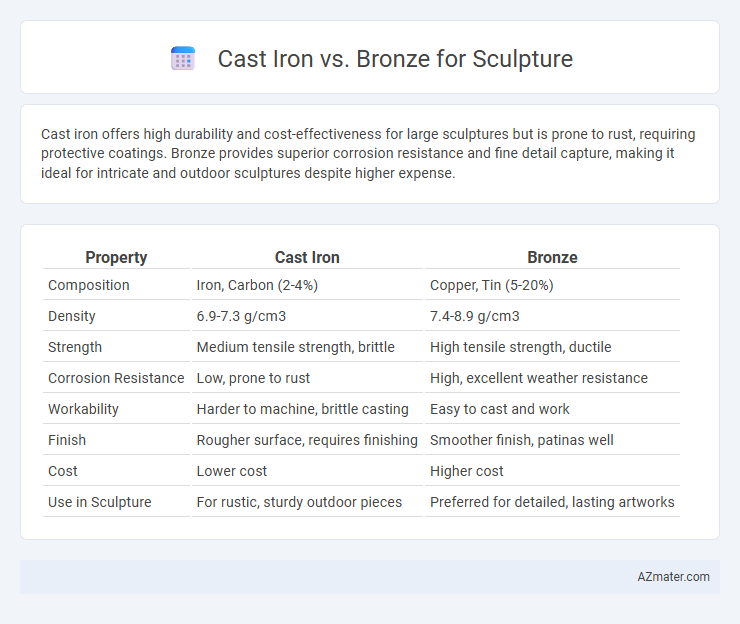Cast iron offers high durability and cost-effectiveness for large sculptures but is prone to rust, requiring protective coatings. Bronze provides superior corrosion resistance and fine detail capture, making it ideal for intricate and outdoor sculptures despite higher expense.
Table of Comparison
| Property | Cast Iron | Bronze |
|---|---|---|
| Composition | Iron, Carbon (2-4%) | Copper, Tin (5-20%) |
| Density | 6.9-7.3 g/cm3 | 7.4-8.9 g/cm3 |
| Strength | Medium tensile strength, brittle | High tensile strength, ductile |
| Corrosion Resistance | Low, prone to rust | High, excellent weather resistance |
| Workability | Harder to machine, brittle casting | Easy to cast and work |
| Finish | Rougher surface, requires finishing | Smoother finish, patinas well |
| Cost | Lower cost | Higher cost |
| Use in Sculpture | For rustic, sturdy outdoor pieces | Preferred for detailed, lasting artworks |
Introduction to Sculpture Materials
Cast iron and bronze serve as primary metals in sculpture due to their distinct properties and historical significance. Cast iron offers durability and a rugged texture, making it suitable for large-scale, outdoor sculptures, while bronze is favored for its malleability, corrosion resistance, and ability to capture fine details, essential for intricate works. Understanding the thermal and mechanical differences between these metals is crucial for artists selecting materials that align with their creative goals and longevity requirements.
Overview of Cast Iron in Sculpture
Cast iron offers exceptional durability and weight, making it suitable for large-scale sculptures exposed to outdoor conditions. Its high compressive strength and ability to capture fine details during casting provide artists with versatility in texture and form. Despite its brittleness compared to bronze, cast iron's cost-effectiveness and distinctive dark patina make it a favored material in industrial and modern sculptural art.
Characteristics of Bronze for Sculpting
Bronze offers superior tensile strength and durability, making it ideal for detailed sculptures that require fine lines and intricate features. Its corrosion resistance ensures long-lasting outdoor display without significant degradation, while its warm, golden-brown patina enhances the aesthetic appeal over time. The metal's excellent casting properties allow for precise and smooth finishes, capturing the artist's intended texture and expression with high fidelity.
Durability: Cast Iron vs Bronze
Bronze offers superior durability for sculptures due to its resistance to corrosion and ability to withstand outdoor weathering without rusting, unlike cast iron which is prone to oxidation and rust over time. Cast iron sculptures require protective coatings or regular maintenance to prevent deterioration when exposed to moisture. The inherent corrosion resistance of bronze ensures longer-lasting preservation of fine details and structural integrity in outdoor environments compared to cast iron.
Workability and Artistic Flexibility
Cast iron offers high durability but is challenging to work with due to its brittleness and limited malleability, restricting detailed artistic expression. Bronze provides superior workability with its excellent malleability and tensile strength, enabling intricate designs and fine textures in sculpture. Artists prefer bronze for its ability to capture delicate details and smooth finishes, enhancing creative flexibility in various sculpting techniques.
Aesthetic Differences in Finish and Color
Cast iron sculptures exhibit a dark, matte finish with subtle texture variations that emphasize rugged, industrial aesthetics, while bronze offers a rich, warm patina that deepens over time, enhancing its classical and elegant appearance. The color range of cast iron remains predominantly gunmetal gray to black, whereas bronze displays hues from golden yellow to deep brown, often developing greenish verdigris due to oxidation. Choosing between cast iron and bronze significantly impacts the visual tone and surface complexity of sculptural works, with bronze favored for its timeless luster and cast iron prized for its raw, robust character.
Cost and Accessibility Comparison
Cast iron offers a more affordable option for sculpture due to its lower material cost and widespread availability, making it accessible for large-scale or budget-conscious projects. Bronze, while significantly more expensive because of its alloy composition and complex casting process, provides superior durability and finer detail, which often justifies the higher investment for professional artists. Accessibility to bronze may be limited by supplier and foundry availability, whereas cast iron benefits from broader industrial supply chains and more common foundry services.
Historical Use in Sculpture
Cast iron and bronze have both played significant roles in the history of sculpture, with bronze favored for its durability, workability, and ability to capture fine details, making it the principal medium for classical and Renaissance statuary. Cast iron emerged as a popular material during the Industrial Revolution, valued for its strength and affordability, enabling large-scale architectural sculptures and public monuments. While bronze remains the traditional choice for its aesthetic qualities and resistance to corrosion, cast iron has been instrumental in expanding the possibilities of sculptural form and mass production in the 19th and 20th centuries.
Maintenance and Longevity
Cast iron sculptures require regular maintenance to prevent rust and corrosion, especially in outdoor environments, where protective coatings must be reapplied periodically. Bronze sculptures exhibit superior longevity with natural patina forming over time, acting as a protective layer that reduces the need for frequent upkeep. Both materials endure well under proper care, but bronze's resistance to weathering and minimal maintenance demands make it the preferred choice for long-lasting sculptural works.
Choosing the Right Material for Your Sculpture
Cast iron offers durability and a distinct industrial aesthetic, making it ideal for large outdoor sculptures exposed to harsh weather conditions. Bronze provides superior detail and a classic patina, favored for fine art sculptures requiring intricate textures and enduring visual appeal. Selecting between cast iron and bronze depends on factors like desired finish, structural strength, budget, and longevity in specific environmental settings.

Infographic: Cast iron vs Bronze for Sculpture
 azmater.com
azmater.com